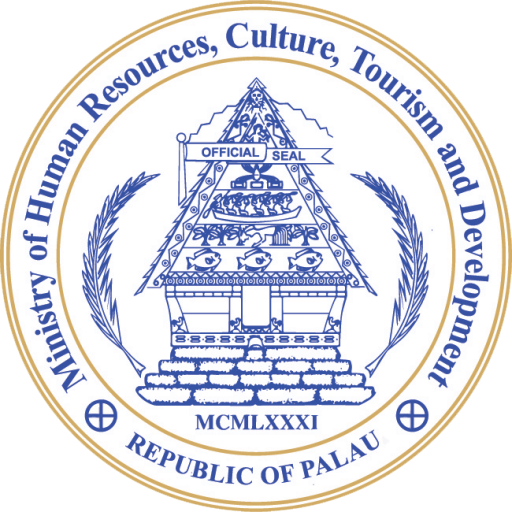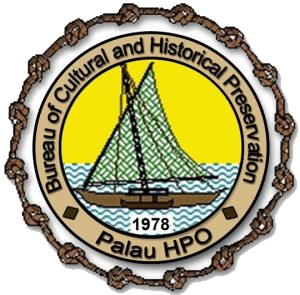Photo by McMichael Mutok Jr. (December 2022)
Badrulchau
The Stone Monoliths of Ngarchelong
- Ngarchelong
Site Type
Date Registered
Site No
Restored
In recognition of its significance, this site has been listed on the Palau Register of Historic Places on September 13, 1989. Through preservation, study, and interpretation, the site can serve to educate future generations concerning the historical and cultural heritage of the Palauan people.
Badrulchau is the name of an area on the large island of Northern Babeldaob containing the most impressive archaeological site in Palau. Covering an area of five acres, it contains over 34 monolith columns on the ancient terraces between Ollei and Mengellang hamlets which are at least 500 yards from the shore line. The area is periodically cleaned and maintained by the Ngarchelong State Government. There appears to be no damage to the stones, however, the fallen columns buried in the soil have not been examined for deterioration. There are three columns carved in the style typical to all ancient stone carvings in Palau. Exact measurements vary according to monolith, but generally all monoliths measure about 3 feet in length and width, and are over 7 feet in height.
Oral History
There is one version of the Badrulchau story that says all parts of Badrulchau were mined from Lukes, a fairly shallow area between Peleliu and Angaur. At that time it was said that the universe was dark and the gods were able to work only in the dark. They assigned the different parts of the Bai (Badrulchau) among themselves and commenced on their assigned tasks. Those that were assigned to mine the foundation were the first to finish and they started carrying these foundation parts to Ngarchelong. They started digging and placing some of the stones in place, while the others with the beams and parts of the roof were carrying these parts over the east coast towards the building site.
Among the gods who were there at the site, digging the foundation, were Medechii Belau who was a sort of trickster, and he was behind in his part of the digging, Medechii Belau seeing his situation did not want to be behind in his work , so he got a coconut husk and made magic and lit the husk and threw it on the ground. The husk turned into a rooster and started crowing signifying the approach of dawn. With the approach of dawn, all the gods abandoned all their work and went away. The others who were bringing the other parts of the Bai left them where ever they were and went away as well. Therefore it is said that parts of the Bai could be found at other areas of Palau. Even the taro pounding implements were abandoned in Ngerudechong of Ngerbau in Ngarchelong. Ngerudechong is a place close to Badrulchau. When the rooster crowed, light dawned on the Universe and there has been light since. There is also a rooster whose color is called Delul el Suld, literally meaning burned coconut husk.
Compiled by McMichael Mutok Jr.
Palau National Register of Historic Places
Bureau of Cultural and Historical Preservation
Sign up to receive the BCHP monthly newsletter.
Significance
There are many stories concerning Badrulchau. Some say gods or supernatural spirits constructed the columns possibly as a support for a Bai type of building; others say that Portuguese were responsible. Legend has it that a Portuguese ship was wrecked near Kayangel island long ago. The sailors settled on this island later came to Babeldaob island (site of Badrulchau). Few archaeologists have visited this site and report that due to various evidences, including radio carbon dating, work on these columns dates back to 150 A.D. Once positive findings are made by archaeologists, it will clarify the early history of Palau. In the meantime, the site is respected by Palauans as an important link in their history and the area is not used for other purposes presently.
Source
Oral History and Archaeological Report are collected from the Ngarchelong State Government Brochure of Badrulchau ( The Stone Monoliths of Ngarchelong), Bureau of Cultural and Historical Preservation Survey Report and the Palau Register of Historic Places Nomination Form.
CODE OF CONDUCT
Given the importance of this site to Palauans in terms of their history and culture and the concerns that exist in regard to its future, those visiting the site should not engage in any type of behavior or activity that disturbs the integrity of this site or diminishes the respect that should be accorded to it.
PALAU HISTORIC PRESERVATION GUIDELINES
Because of the importance and sensitivity surrounding this and all historical registered sites, the Palau Historic Preservation Office would like to emphasize proper conduct for visiting a site through the following guidelines.
1) Remember that many sites include culturally sensitive areas and therefore behavior should be always be respectful.
2) Remember to take everything you bring to the site with you when you leave.
3) Do not remove anything from the site. Although you may not think something is significant to the site, all pieces make up the whole.
Location of Badrulchau Stone Monoliths
Compiled by McMichael Mutok Jr.
Palau National Register of Historic Places
Bureau of Cultural and Historical Preservation




